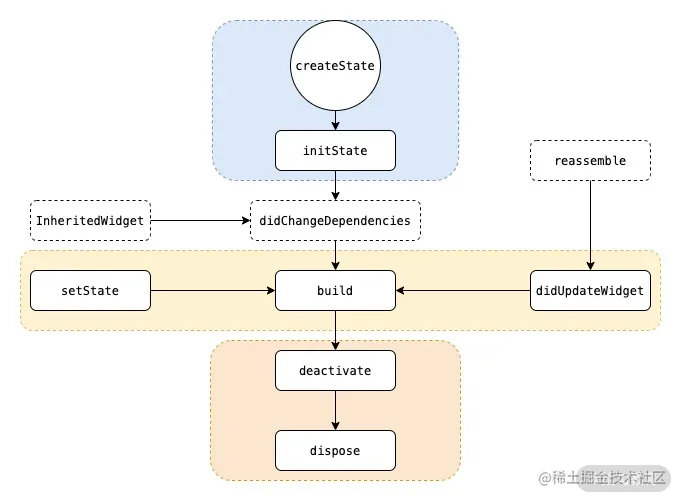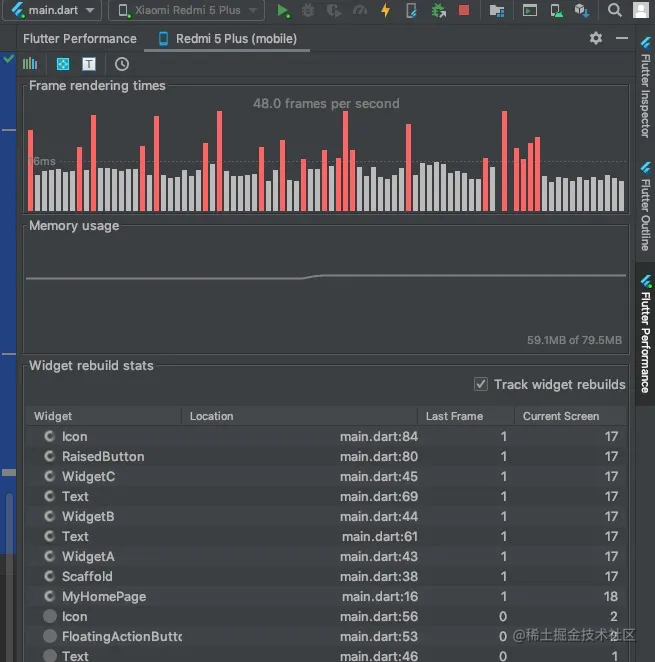【Flutter进阶】聊一聊组件中的生命周期、状态管理及局部重绘
前言
说到生命周期,熟悉Android开发的小伙伴一定第一时间会想到Activity的生命周期,由于在Flutter中一切都是组件,所以组件的生命周期其实是类似的。
在这个过程中组件的状态——State就非常重要,它记录这整个组件内可变部分的状态,当状态发生改变时就需要刷新组件以显示最新的状态。
当然,如果组件比较复杂的时候,其中一个状态改变就导致整个组件的刷新是不可取的,这就涉及到Flutter中的局部重绘即局部刷新的机制。
本篇文章就通过这三个方面,来详细的解读Flutter中相关的机制以及如何使用。
生命周期
flutter的生命周期其实有两种:StatefulWidget和StatelessWidget。
这两个是flutter的两个基本组件,名称已经很好表明了这两个组件的功能:有状态和无状态。
- StatelessWidget
StatelessWidget是无状态组件,它的生命周期非常简单,只有一个build,如下:
class WidgetA extends StatelessWidget {
Widget build(BuildContext context) {
return ...;
}
}
对于StatelessWidget来说只渲染一次,之后它就不再有任何改变。
由于无状态组件在执行过程中只有一个 build 阶段,在执行期间只会执行一个 build 函数,没有其他生命周期函数,因此在执行速度和效率方面比有状态组件更好。所以在设计组件时,要考虑业务情况,尽量使用无状态组件。
- StatefulWidget
StatelessWidget是有状态组件,我们讨论的生命周期也基本指它的周期,如图:

包含以下几个阶段:
-
createState:该函数为 StatefulWidget 中创建 State 的方法,当 StatefulWidget 被调用时会立即执行 createState 。
-
initState:该函数为 State 初始化调用,因此可以在此期间执行 State 各变量的初始赋值,同时也可以在此期间与服务端交互,获取服务端数据后调用 setState 来设置 State。
-
didChangeDependencies:该函数是在该组件依赖的 State 发生变化时,这里说的 State 为全局 State ,例如语言或者主题等,类似于前端 Redux 存储的 State 。
-
build:主要是返回需要渲染的 Widget ,由于 build 会被调用多次,因此在该函数中只能做返回 Widget 相关逻辑,避免因为执行多次导致状态异常,注意这里的性能问题。
-
reassemble:主要是提供开发阶段使用,在 debug 模式下,每次热重载都会调用该函数,因此在 debug 阶段可以在此期间增加一些 debug 代码,来检查代码问题。
-
didUpdateWidget:该函数主要是在组件重新构建,比如说热重载,父组件发生 build 的情况下,子组件该方法才会被调用,其次该方法调用之后一定会再调用本组件中的 build 方法。
-
deactivate:在组件被移除节点后会被调用,如果该组件被移除节点,然后未被插入到其他节点时,则会继续调用 dispose 永久移除。
-
dispose:永久移除组件,并释放组件资源。
在StatelessWidget中,只要我们调用setState,就会执行重绘,也就是说重新执行build函数,这样就可以改变ui。
组件刷新
先来看看下方的代码:
class MyHomePage extends StatefulWidget {
_MyHomePageState createState() => _MyHomePageState();
}
class _MyHomePageState extends State<MyHomePage> {
int _counter = 0;
void _incrementCounter() {
setState(() {
_counter++;
});
}
Widget build(BuildContext context) {
return Scaffold(
body: Center(
child: Column(
mainAxisAlignment: MainAxisAlignment.center,
children: [
WidgetA(_counter),
WidgetB(),
WidgetC(_incrementCounter)
],
),
),
);
}
}
class WidgetA extends StatelessWidget {
final int counter;
WidgetA(this.counter);
Widget build(BuildContext context) {
return Center(
child: Text(counter.toString()),
);
}
}
class WidgetB extends StatelessWidget {
Widget build(BuildContext context) {
return Text('I am a widget that will not be rebuilt.');
}
}
class WidgetC extends StatelessWidget {
final void Function() incrementCounter;
WidgetC(this.incrementCounter);
Widget build(BuildContext context) {
return RaisedButton(
onPressed: () {
incrementCounter();
},
child: Icon(Icons.add),
);
}
}
我们有三个Widget,一个负责显示count,一个按钮改变count,一个则是静态显示文字,通过这三个Widget来对比比较页面的刷新逻辑。
上面代码中,三个Widget是在_MyHomePageState的build中创建的,执行后点击按钮可以发现三个Widget都刷新了。
在Flutter Performance面板上选中Track Widget Rebuilds即可看到

虽然三个Widget都是无状态的StatelessWidget,但是因为_MyHomePageState的State改变时会重新执行build函数,所以三个Widget会重新创建,这也是为什么WidgetA虽然是无状态的StatelessWidget却依然可以动态改变的原因。
所以:无状态的StatelessWidget并不是不能动态改变,只是在其内部无法通过State改变,但是其父Widget的State改变时可以改变其构造参数使其改变。实际上确实不能改变,因为是一个新的实例。
下面我们将三个组件提前创建,可以在_MyHomePageState的构造函数中创建,修改后代码如下:
class _MyHomePageState extends State<MyHomePage> {
int _counter = 0;
List<Widget> children;
_MyHomePageState(){
children = [
WidgetA(_counter),
WidgetB(),
WidgetC(_incrementCounter)
];
}
void _incrementCounter() {
setState(() {
_counter++;
});
}
Widget build(BuildContext context) {
return Scaffold(
body: Center(
child: Column(
mainAxisAlignment: MainAxisAlignment.center,
children: children,
),
),
);
}
}
再次执行,发现点击没有任何效果,Flutter Performance上可以看到没有Widget刷新(这里指三个Widget,当然Scaffold还是刷新了)。
这是因为组件都提前创建了,所以执行build时没有重新创建三个Widget,所以WidgetA显示的内容并没有改变,因为它的counter没有重新传入。
所以,不需要动态改变的组件可以提前创建,build时直接使用即可,而需要动态改变的组件实时创建。
这样就可以实现局部刷新了么?我们继续改动代码如下:
class _MyHomePageState extends State<MyHomePage> {
int _counter = 0;
Widget b = WidgetB();
Widget c ;
_MyHomePageState(){
c = WidgetC(_incrementCounter);
}
void _incrementCounter() {
setState(() {
_counter++;
});
}
Widget build(BuildContext context) {
return Scaffold(
body: Center(
child: Column(
mainAxisAlignment: MainAxisAlignment.center,
children: [
WidgetA(_counter),
b,
c
],
),
),
);
}
}
我们只将WidgetB和WidgetC重新创建,而WidgetA则在build中创建。执行后,点击按钮WidgetA的内容改变了,查看Flutter Performance可以看到只有WidgetA刷新了,WidgetB和WidgetC没有刷新。

所以:通过提前创建静态组件build时直接使用,而build时直接创建动态Widget 这种方式可以实现局部刷新。
注意:
只要setState,_MyHomePageState就会刷新,所以WidgetA就会跟着刷新,即使count没有改变。比如上面代码中将setState中的_count++代码注释掉,再点击按钮虽然内容没有改变,但是WidgetA依然刷新。
这种情况可以通过InheritedWidget来进行优化。
InheritedWidget
InheritedWidget的作用什么?网上有人说是数据共享,有人说是用于局部刷新。我们看官方的描述:
Base class for widgets that efficiently propagate information down the tree.
可以看到它的作用是Widget树从上到下有效的传递消息,所以很多人理解为数据共享,但是注意这个“有效的”,这个才是它的关键,而这个有效的其实就是解决上面提到的问题。
那么它怎么使用?
先创建一个继承至InheritedWidget的类:
class MyInheriteWidget extends InheritedWidget{
final int count;
MyInheriteWidget({ this.count, Widget child}) : super(child: child);
static MyInheriteWidget of(BuildContext context){
return context.dependOnInheritedWidgetOfExactType<MyInheriteWidget>();
}
bool updateShouldNotify(MyInheriteWidget oldWidget) {
return oldWidget.count != count;
}
}
这里将count传入。重点注意要实现updateShouldNotify函数,通过名字可以知道这个函数决定InheritedWidget的Child Widget是否需要刷新,这里我们判断如果与之前改变了才刷新。这样就解决了上面提到的问题。
然后还要实现一个static的of方法,用于Child Widget中获取这个InheritedWidget,这样就可以访问它的count属性了,这就是消息传递,即所谓的数据共享(因为InheritedWidget的child可以是一个layout,里面有多个widget,这些widget都可以使用这个InheritedWidget中的数据)。
然后我们改造一下WidgetA:
class WidgetA extends StatelessWidget {
Widget build(BuildContext context) {
final MyInheriteWidget myInheriteWidget = MyInheriteWidget.of(context);
return Center(
child: Text(myInheriteWidget.count.toString()),
);
}
}
这次不用在构造函数中传递count了,直接通过of获取MyInheriteWidget,使用它的count即可。
最后修改_MyHomePageState:
class _MyHomePageState extends State<MyHomePage> {
int _counter = 0;
Widget a = WidgetA();
Widget b = WidgetB();
Widget c ;
_MyHomePageState(){
c = WidgetC(_incrementCounter);
}
void _incrementCounter() {
setState(() {
_counter++;
});
}
Widget build(BuildContext context) {
return Scaffold(
body: Center(
child: Column(
mainAxisAlignment: MainAxisAlignment.center,
children: [
MyInheriteWidget(
count: _counter,
child: a,
),
b,
c
],
),
),
);
}
}
注意,这里用MyInheriteWidget包装一下WidgetA,而且WidgetA必须提前创建,如果在build中创建则每次MyInheriteWidget刷新都会跟着刷新,这样updateShouldNotify函数的效果就无法达到。
执行,点击按钮,可以发现只有WidgetA刷新了(当然MyInheriteWidget也刷新了)。如果注释掉setState中的_count++代码,再执行并点击发现虽然MyInheriteWidget刷新了,但是WidgetA并不刷新,因为MyInheriteWidget的count并未改变。
下面我们改动一下代码,将WidgetB和C都放入MyInheriteWidget会怎样?
Widget build(BuildContext context) {
return Scaffold(
body: Center(
child: Column(
mainAxisAlignment: MainAxisAlignment.center,
children: [
MyInheriteWidget(
count: _counter,
child: Column(
children: [
a,
b,
c
],
),
),
],
),
),
);
}
}
MyInheriteWidget的child是一个Column,将a、b、c都放在这下面。执行会发现依然是WidgetA刷新,B和C都不刷新。这是因为在B和C中没有执行MyInheriteWidget的of函数,就没有执行dependOnInheritedWidgetOfExactType,这样其实就没构成依赖,MyInheriteWidget就不会通知它们。
如果我们修改WidgetC,在build函数中添加一行MyInheriteWidget.of(context);那么虽然没有任何使用,依然能会跟着刷新,因为建立了依赖关系就会被通知。
InheritedWidget会解决多余的刷新问题,比如在一个页面中有多个属性,同样有多个Widget来使用这些属性,但是并不是每个Widget都使用所有属性。如果用最普通的实现方式,那么每次setState(无论改变哪个属性)都需要刷新这些Widget。但是如果我们用多个InheritedWidget来为这些Widget分类,使用相同属性的用同一个InheritedWidget来包装,并实现updateShouldNotify,这样当改变其中一个属性时,只有该属性相关的InheritedWidget才会刷新它的child,这样就提高了性能。
InheritedModel
InheritedModel是继承至InheritedWidget的,扩充了它的功能,所以它的功能更加强大。具体提现在哪里呢?
通过上面我们知道,InheritedWidget可以通过判断它的data是否变化来决定是否刷新child,但是实际情况下这个data可以是多个变量或者一个复杂的对象,而child也不是单一widget,而是一系列widget组合。比如展示一本书,数据可能有书名、序列号、日期等等,但是每个数据可能单独变化,如果用InheritedWidget,就需要每种数据需要一个InheritedWidget类,然后将使用该数据的widget包装,这样才能包装改变某个数据时其他widget不刷新。
但是这样的问题就是widget层级更加复杂混乱,InheritedModel就可以解决这个问题。InheritedModel最大的功能就是根据不同数据的变化刷新不同的widget。下面来看看如何实现。
首先创建一个InheritedModel:
class MyInheriteModel extends InheritedModel<String>{
final int count1;
final int count2;
MyInheriteModel({ this.count1, this.count2, Widget child}) : super(child: child);
static MyInheriteModel of(BuildContext context, String aspect){
return InheritedModel.inheritFrom(context, aspect: aspect);
}
bool updateShouldNotify(MyInheriteModel oldWidget) {
return count1 != oldWidget.count1 || count2 != oldWidget.count2;
}
bool updateShouldNotifyDependent(MyInheriteModel oldWidget, Set<String> dependencies) {
return (count1 != oldWidget.count1 && dependencies.contains("count1")) ||
(count2 != oldWidget.count2 && dependencies.contains("count2"));
}
}
这里我们传入两个count,除了实现updateShouldNotify方法,还需要实现updateShouldNotifyDependent方法。这个函数就是关键,可以看到我们判断某个数据是否变化后还判断了dependencies中是否包含一个关键词:
count1 != oldWidget.count1 && dependencies.contains(“count1”)
这个关键词是什么?从哪里来?后面会提到,这里先有个印象。
然后同样需要实现一个static的of函数来获取这个InheritedModel,不同的是这里获取的代码变化了:
InheritedModel.inheritFrom(context, aspect: aspect);
这里的aspect就是后面用到的关键字,而inheritFrom会将这个关键字放入dependencies,以便updateShouldNotifyDependent来使用。后面会详细解释这个aspect完整作用。
然后我们改造WidgetA:
class WidgetA extends StatelessWidget {
Widget build(BuildContext context) {
final MyInheriteModel myInheriteModel = MyInheriteModel.of(context, "count1");
return Center(
child: Text(myInheriteModel.count1.toString()),
);
}
}
可以看到,这里定义了aspect。
然后因为有两个count,所以我们再新增两个Widget来处理count2:
class WidgetD extends StatelessWidget {
Widget build(BuildContext context) {
final MyInheriteModel myInheriteModel = MyInheriteModel.of(context, "count2");
return Center(
child: Text(myInheriteModel.count2.toString()),
);
}
}
class WidgetE extends StatelessWidget {
final void Function() incrementCounter;
WidgetE(this.incrementCounter);
Widget build(BuildContext context) {
return RaisedButton(
onPressed: () {
incrementCounter();
},
child: Icon(Icons.add),
);
}
}
这里可以看到WidgetD的aspect与WidgetA是不同的。
最后修改_MyHomePageState:
class _MyHomePageState extends State<MyHomePage> {
int _counter = 0;
int _counter2 = 0;
Widget a = Row(
children: [
WidgetA(),
WidgetD()
],
);
Widget b = WidgetB();
Widget c ;
Widget e ;
_MyHomePageState(){
c = WidgetC(_incrementCounter);
e = WidgetE(_incrementCounter2);
}
void _incrementCounter() {
setState(() {
_counter++;
});
}
void _incrementCounter2() {
setState(() {
_counter2++;
});
}
Widget build(BuildContext context) {
return Scaffold(
body: Center(
child: Column(
mainAxisAlignment: MainAxisAlignment.center,
children: [
MyInheriteModel(
count1: _counter,
count2: _counter2,
child: a,
),
b,
c,
e
],
),
),
);
}
}
WidgetD和E是处理count2的,A和C则是处理count。而MyInheriteModel的child不是单一Widget,而是一个Row,包含WidgetD和A。
执行代码,可以发现点击WidgetC的时候,只有WidgetA刷新了(当然MyInheriteModel也刷新);而点击WidgetD的时候,只有WidgetE刷新了。这样我们就实现了MyInheriteModel中的局部刷新。
其实原理很简单,aspect就相当于一个标记,当我们通过InheritedModel.inheritFrom(context, aspect: aspect);获取MyInheriteModel时,实际上将本Widget依赖到MyInheriteModel,并且将这个Widget标记。这时候如果data改变,遍历它的所有依赖时,会通过每个依赖的Widget获取它对应的标记集dependencies,然后触发updateShouldNotifyDependent判断该Widget是否刷新。
所以在InheritedModel(其实是InheritedElement)中存在一个map,记录了每个依赖的Widget对应的dependencies,所以一个Widget可以有多个标记,因为dependencies是一个Set,这样就可以响应多个数据的变化(比如多个数据组成一个String作为文本显示)。
上面其实可以用两个InheritedWidget也可以实现,但是布局越复杂,就需要越多的InheritedWidget,维护起来也费时费力。
所以可以看到InheritedModel使用更灵活,功能更强大,更适合复杂的数据和布局使用,并且通过细分细化每一个刷新区域,使得每次刷新都只更新最小区域,极大的提高了性能。
InheritedNotifier
InheritedNotifier同样继承至InheritedWidget,它是一个给Listenable的子类的专用工具,它的构造函数中要传入一个Listenable(这是一个接口,不再是之前的各种数据data),比如动画(如AnimationController),然后其依赖的组件则根据Listenable进行更新。
首先还是先创建一个InheritedNotifier:
class MyInheriteNotifier extends InheritedNotifier<AnimationController>{
MyInheriteNotifier({
Key key,
AnimationController notifier,
Widget child,
}) : super(key: key, notifier: notifier, child: child);
static double of(BuildContext context){
return context.dependOnInheritedWidgetOfExactType<MyInheriteNotifier>().notifier.value;
}
}
这里提供的of函数则直接返回AnimationController的value即可。
然后创建一个Widget:
class Spinner extends StatelessWidget {
Widget build(BuildContext context) {
return Transform.rotate(
angle: MyInheriteNotifier.of(context) * 2 * pi,
child: Text("who!!"),
);
}
}
内容会根据AnimationController进行旋转。
修改WidgetA:
class WidgetA extends StatelessWidget {
Widget build(BuildContext context) {
return Center(
child: Text("WidgetA"),
);
}
}
然后修改_MyHomePageState:
class _MyHomePageState extends State<MyHomePage6> with SingleTickerProviderStateMixin {
AnimationController _controller;
void initState() {
super.initState();
_controller = AnimationController(
vsync: this,
duration: Duration(seconds: 10),
)..repeat();
}
Widget build(BuildContext context) {
return Scaffold(
body: Center(
child: Column(
mainAxisAlignment: MainAxisAlignment.center,
children: [
WidgetA(),
MyInheriteNotifier(
notifier: _controller,
child: Spinner()
),
],
),
),
);
}
}
运行会看到Text在不停的旋转,当然如果有其他Widget可以看到并不跟着刷新。
总之InheritedNotifier是一个更细化的工具,聚焦到一个具体场景中,使用起来也更方便。
Notifier
最后再简单介绍一下Notifier,考虑一个需求:页面A是列表页,而页面B是详情页,两个页面都有点赞操作和显示点赞数量,需要在一个页面点赞后两个页面的数据同时刷新。这种情况下就可以使用flutter提供另外一种方式——Notifier。
Notifier其实就是订阅模式的实现,主要包含ChangeNotifier和ValueNotifier,使用起来也非常简单。通过addListener和removeListener进行订阅和取消订阅(参数是无参无返回值的function),当数据改变时调用notifyListeners();通知即可。
ValueNotifier是更简单的ChangeNotifier,只有一个数据value,可以直接进行set和get,set时自动执行notifyListeners(),所以适合单数据的简单场景。
当时注意Notifier只是共享数据并通知变化,并不实现刷新,所以还要配合其他一并实现。比如上面的InheritedNotifier(因为Notifier都继承Listenable接口,所以两个可以很简单的配合使用),或者第三方库Provider(web开发的习惯)等等。
总结
本篇文章中提到的有关生命周期、组件状态、局部重绘等机制在Flutter开发中非常重要,了解相关知识不仅能让代码逻辑更清晰,同时也会提高应用流畅度,减少bug的出现。
Flutter的特点是跨平台,另外一个特点就是混合开发,这就涉及到与原生代码的交互,可以看这几篇博客:
【Flutter进阶】与Native进行交互的三种方式
【Flutter混合开发】在已有iOS项目中引入Flutter
【Flutter混合开发】在Android项目中如何启动Flutter
